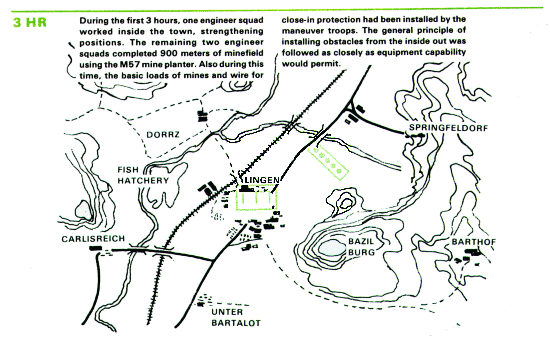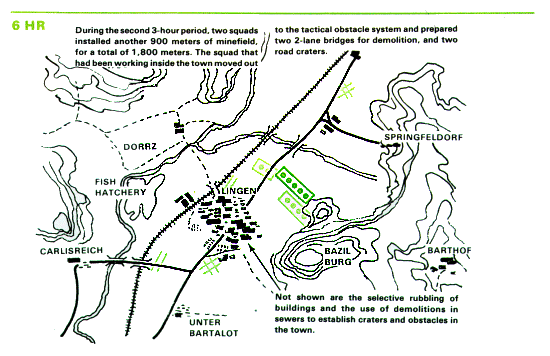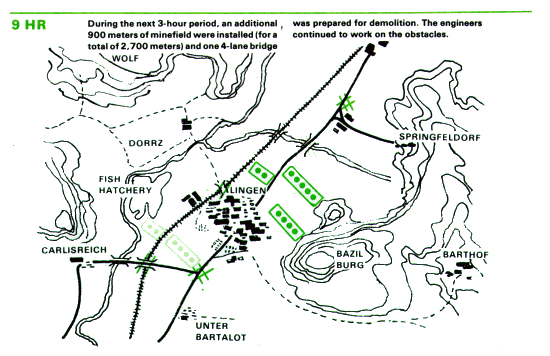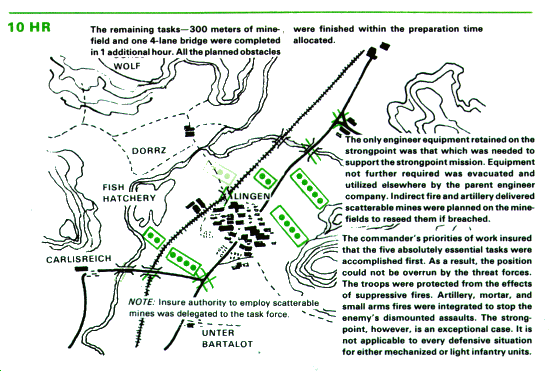|
Table of Contents |
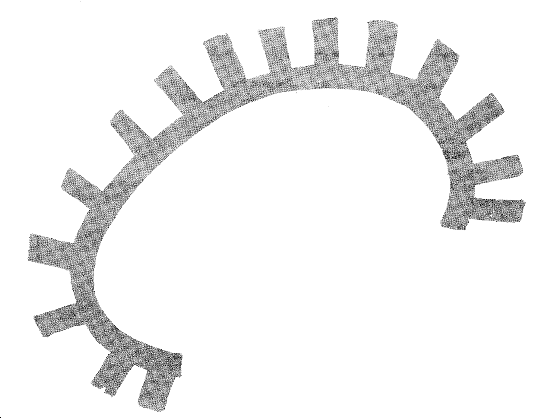
This appendix gives insight to develop a strongpoint into the mission. A strongpoint is the cork in a bottleneck formed by terrain, obstacles, and units. This countermobility tactic is essentially an antitank "nest" which physically cannot be overrun or bypassed by tanks, and which can be reduced by enemy infantry only with considerable expenditure of time and forces. It is similar to a perimeter defense in that it is developed to defeat an attack from any direction. It is distinguished from other defensive positions by the key use of terrain and by the time, effort, and resources dedicated to its development.
In some cases, the brigade or division commander may direct that a strongpoint be emplaced by a battalion or company-sized unit. There are several important aspects about a strongpoint that need to be clearly understood. A strongpoint is not routinely established. It is established only after the commander determines that a strongpoint is absolutely necessary to prevent decisive penetration of the defensive system by enemy armor. The decision must be carefully weighed against the following impacts:
Assignment of this mission presupposes that--
A strongpoint must be emplaced far enough from the line of contact to provide the necessary development time. Terrain to the flanks must restrict the advance of the mounted attacker. The maneuver commander, upon receiving the mission to establish a strongpoint, immediately conducts a joint reconnaissance with the leader of the supporting engineer element to establish the optimum application of available assets. The strongpoint is prepared in accordance with the following broad priorities:
Building block concept
The building block approach permits engineer efforts to be planned in terms of manpower, equipment, time, and materials for typical emplacement tasks. This concept provides flexibility to the engineer in that estimates can readily be made for any strongpoint size or design. The building blocks are as follows:
Essential tasks
The following five essential engineer tasks must be performed for all strongpoints.
A brigade consisting of four battalion task forces is defending along a corridor. Its mission is to stop the enemy in sector, and prevent him from gaining access to the more favorable terrain. The strongpoint must be completed within 10 hours.
The highway in the valley is the only high-speed approach through the sector. This road is vital to maintaining the momentum of the enemy's attack, and also vital to his ability to sustain ground operations. The alternative is to attempt the time-consuming maneuver over restrictive terrain.
The brigade commander knows that the threat will move its motorized forces on the high-speed avenue of approach. If the commander fails to control the road, the brigade defense will crumble throughout the sector. The brigade commander determines that a strongpoint is absolutely necessary to prevent a decisive penetration of the defensive system by enemy armor.
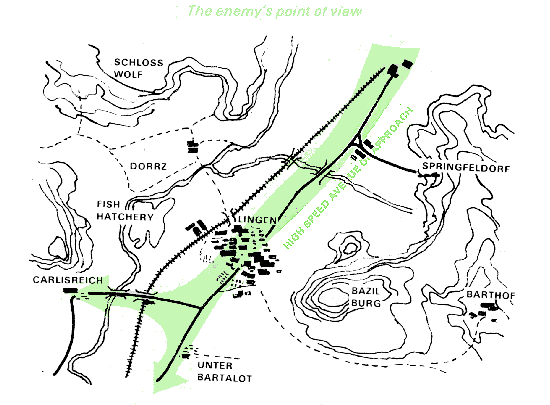
The best way to block the enemy is to establish a strongpoint in the valley. The valley is open, flat, and approximately 4 kilometers wide. The hilly terrain on both flanks provides excellent sites for battle positions. The Blau River and the marshy areas all along its course further narrow the valley. A succession of small villages along the valley floor provides excellent battle position locations, but fails to fully block the avenue. Near the rear boundary of the sector, only the town of Lingen offers a position which blocks the valley. In conjunction with the fish hatcheries, the Bazil Burg, and Schloss Wolf, the town forms a chokepoint. It fulfills all the requirements of a strongpoint for the tactical plan, and can readily be established within the time constraints. The brigade commander assigns the mission to the mechanized infantry battalion. The commander of the normally-associated engineer company and the battalion commander made a joint recon of the area and prepared resource and time estimates.
Tasks
In addition to the five essential engineer tasks, the following tasks are also performed for this strongpoint. The tactical commander could vary these additional tasks as the situation changes.
The maneuver units can handle the bulk of the preparation of the individual and light crew-served weapon positions, thus allowing the engineers to concentrate on key positions, the obstacles, and interconnecting routes. The Combat Engineer Vehicle (CEV) is assigned to work in the town where its demolition gun and blade could both be used to create and use rubble for positions, obstacles, and protected routes between positions.
Although maneuver units are trained in and have demolitions as part of their basic load, engineers assist with technical advice in their use. Most of the initial demolition work inside the town is done by the maneuver units. The engineer platoon effort, to include demolitions, initially goes into building the obstacle system. When that is finished, the platoon will join the maneuver units in improving positions by using sandbags, rubble, and locally available building materials to strengthen walls, beams, and overhead cover. Engineer equipment continues to haul and position earth for sandbags and other shoring material.
Sequence of effort
The maneuver units, assisted by engineers, prepare fighting positions, shelters, and protective obstacles using materials from basic loads. An engineer squad uses explosives and assists the maneuver units in employing demolitions and strengthening buildings.
At the same time, the dump truck and loader stockpile earth in each maneuver platoon area for filling sandbags, and the dozer and CEV create and handle rubble for obstacles and covered routes. Outside the town, the ACE and backhoe/loader digs antiarmor positions and the interconnecting trenches.
Concurrently, the engineers begin work on the obstacle plan, which was worked out after a joint reconnaissance by the infantry battalion commander and the supporting engineer platoon leader. The plan ties in minefields, bridge demolitions, and road craters with these obstacles already present: the town, the sunken road, and the Blau River with its associated ponds, marshes, and steep slopes.
